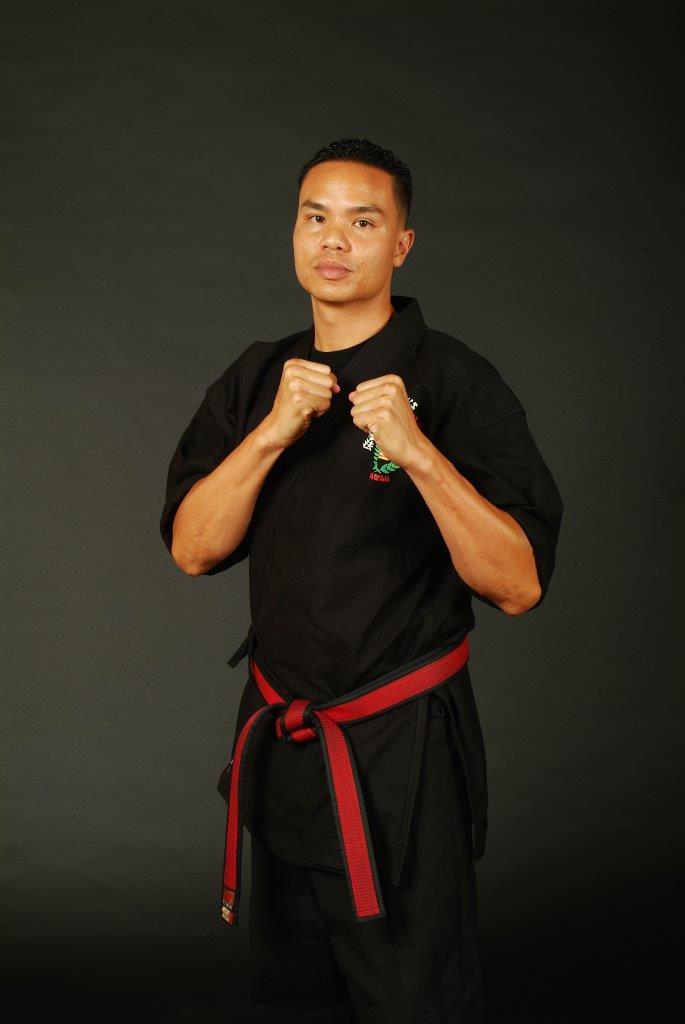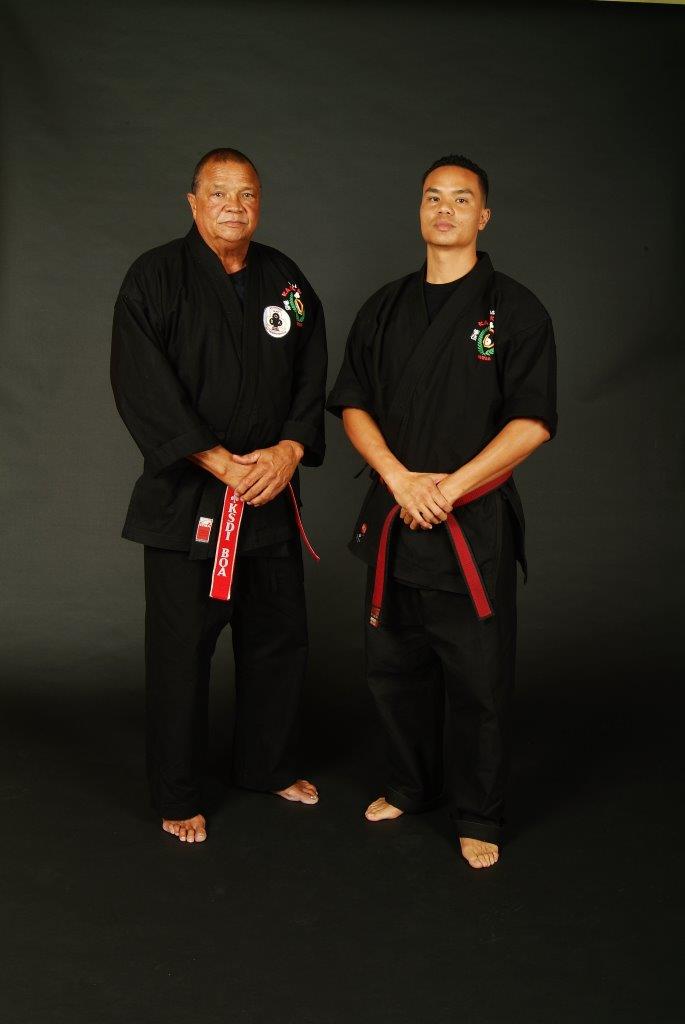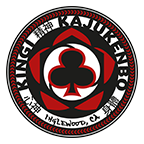Meet Our Instructors
Professor Robert Kingi
Professor Robert began training the moment he was able to take his first steps. Robert had the privilege to train under his Dad, Mom, Brothers & Sister as well all of the other outstanding black belts along the way. Robert received his Jr. Black Belt in 1992 at the age of 10, the youngest Black Belt in the history of Kingi’s Kajukenbo. He then continued his training and competing in tournaments while juggling high school basketball and earned his 1st Degree Black Belt in 1998 at the age of 16. In his early 20’s he, like his father, took up some boxing. He trained briefly at Wild Card Boxing Gym in Hollywood, CA under the tutelage of Freddy Roach. He then set out to compete on the national tournament circuit being sponsored by several teams along the way.
In March of 2010, Robert took over Kingi’s Kajukenbo, finally taking the position he had been groomed for all his life. Robert currently holds the rank of 8th Degree Black Belt in Kajukenbo and is the owner and head instructor of Kingi’s Kajukenbo. His son and daughter have also begun training and are following closely in their father’s footsteps.
Senior Grandmaster Rick Kingi
Senior GM Rick Kingi started his training along with his brothers and some friends. He trained under GGM Carlos Bunda and obtained his 1st Degree Black Belt in 1968. He was GGM Carlos Bunda’s first black belt. During the middle 1960’s, Rick also had the pleasure of training under the late John Leoning and the late Dave Kawashima. Throughout Rick Kingi’s martial arts training, he won numerous tournaments. Just before he became a black belt, the world famous boxing trainer, Eddy Fudge, who trained heavy weight champions like Joe Frazier and George Foreman, saw him at the Hoover Street gym and was very impressed with his boxing skills and speed.
Rick Kingi began teaching in a garage in late 1968. He taught in his father-in-law’s garage in Bell Gardens, California. (By the way, Kajukenbo started in a garage in Hawaii!) One of his first students was his wife Elaine. He then taught in his brother’s garage in Los Angeles. In the summer of 1981, he opened up his very first Kajukenbo school at 209 N. La Brea Ave. in Inglewood, California. His wife Elaine Kingi was one of his first black belts. His four children: Rick Jr., Ron, Kimberly and Robert also were his students and are all now black belts. His youngest son Robert now runs Kingi’s Kajukenbo. Rick is still actively involved, teaching, talking and sharing his wisdom and stories with the students, parents, and instructors. He is a highly sought after instructor for seminars and training throughout the United States and all over the world. Rick is also a key member of the Kajukenbo Board of Advisors, responsible for overseeing promotions to leadership ranks of 8th & 9th Degree within the entire system of Kajukenbo globally.
KAJUKENBO HISTORY
KAJUKENBO is a unique style of martial arts that was created by five black belts from various martial arts backgrounds. They got together and trained with each other to create the ultimate IDEAL FIGHTING ART.
KA (long life) – comes from Karate, an art form that places emphasis on hard and powerful techniques.
The karate influence was from the late Peter Y.Y. Choo.
JU (happiness) – comes from Judo and Ju-jitsu, an art form that places emphasis on throwing, locks and sweeps. The judo and ju-jitsu influence was from the late Joseph Holck and Frank Ordonez.
KEN (fist) – comes from Kenpo, an art form of karate that not only stresses the hard and powerful movements, but emphasizes multiple and fluid hand techniques.
The kenpo influence was from the late Sijo Adriano Emperado.
BO (style) – comes from Chinese boxing. Chinese boxing means Kung-Fu, an art form that places emphasis on flexibility and agility, parrying and evasive movements that flow together.
The Chinese boxing influence was from the late Clarence Chang.
The word KA-JU-KEN-BO together make up the Kajukenbo motto:
Kajukenbo was founded in 1947 in the Palama Settlement on the island of Oahu, Hawaii. In the late 1940’s, the Palamas Settlement was a very violent area where stabbings, fist-fights and killings were common. The five black belts who were responsible for creating Kajukenbo are: Peter Y. Y. Choo, Joseph Holck, Frank Ordonez, Adriano Emperado and Clarence Chang. These five martial artists got together and trained, and learned from each other to develop this effective ideal fighting art.
Kajukenbo developed between the year 1947 and 1949. These five martial artists trained and fought in and around the Palama Settlement, which was the worst slum in Hawaii at the time. They quickly gained the reputations of untouchable street-fighters that would make them invincible in the toughest streets of Hawaii. Their emphasis in training was on realism. To test the effectiveness of a technique, they would get into fist-fights on the streets and in bars, often with sailors who challenged them to a fight, and if the technique worked consistently, then it was kept as part of the system. They became known as the notorious Black Belt Society. It was a policy of the Black Belt Society to never practice in perfecting the Kajukenbo style in one training place/area for fear that this unique system might be exposed. In those days, to conduct a self-defense school, the instructor had to have full knowledge of what he was teaching in the field of martial arts. He had to be strong and in good physical condition in order to take on any comers, such as those who had opened up a self-defense school without any documents stating that he was a qualified instructor to teach martial arts. They began training only a few top martial artists when their ideal fighting art was perfected. However, later they began to teach this style to the public. Again, the emphasis during training was on realism, so students often broke bones, fainted from exhaustion or were knocked unconscious and sent to the hospital.
Kajukenbo Self-Defense Institute, Inc. (K.S.D.I.) started in the 1950’s when Adriano Emperado along with his brother, Joe Emperado, opened a school after the Black Belt Society split up. The training continued to be physically intense, hard and very demanding. Nevertheless, the reputation of this tough new art drew more students and Emperado opened a second school. Soon, Emperado had 12 Kajukenbo schools in Hawaii, making it the second largest string of schools at that time.
Kajukenbo came to California in the winter of 1958. The late John Leoning, who trained under Adriano Emperado and his brother Joe Emperado, left Hawaii to venture out and bring Kajukenbo to the mainland after Joe passed away. With the blessings of Emperado and the Black Belt Society, he had a letter/certificate that wished him well on his venture to California to expand Kajukenbo outside of Hawaii. Hawaii was still a territory of the United States, and John was the first Kajukenbo instructor to teach and practice Kajukenbo outside of Hawaii. His modest beginning was on a small Sunset Blvd. location in Los Angeles. His teaching style was no different from when he was teaching in Hawaii. His classes were 3 hours long, 6 nights per week, plus Saturday afternoons. All of this he would fit in while working full time during the day.
John Leoning’s first student was Carlos Bunda. Carlos Bunda obtained his 1st degree black belt in 1962. In those days, receiving a black belt before 5 years of training was very unusual. Carlos opened up his first school on Venice Blvd. and 4th Ave. in Los Angeles, California, then later moved to Hoover St. in Los Angeles. One of his first students was Rick Kingi. Carlos’ classes were 3 hours long and he made his students squat in a low horse stance for the first half-hour. The basics, foot work, forms and proper technique were strongly emphasized. He would have his students fight each other in the dark with bare knuckles, which was part of the training. It was common to have black eyes, busted lips, cracked heads and swollen fingers and toes. There was no mat, just a hard floor. Every class was a grueling 3 hours long. A person would have to have much determination and endurance to get through the continuous pain and the boredom of doing the same exercises hundreds of times over. They had to do hundreds of push-ups, sit-ups, kicks, blocks and punches. Then they had to “street fight” and spar. Every class was like a test! Carlos Bunda is recognized as being the first to bring attention to the Kajukenbo style of free style fighting. He was the very first Kajukenbo black belt who competed in Ed Parker’s 1st International Tournament in Long Beach, California in 1964. Ed Parker’s Internationals was the biggest tournament at that time. He placed first in fighting in the lightweight division, and was also awarded the sportsmanship trophy that year.
In the 1960’s, wearing protective gear was unheard of at that time. Competitors only wore white gi’s (uniforms), and were very traditional. Whenever Carlos’ students walked into a tournament, they were considered “outlaws,” because they wore black gi’s and executed very hard contact and were considered non-traditional, because the ideal of “mixed martial arts” was unheard of and not recognized at that time.
Carlos Bunda’s first student was Rick Kingi. Rick Kingi started his training along with his brothers and some friends. He trained under Carlos and obtained his 1st degree black belt in 1968. He was Carlos’ first black belt. During the middle 1960’s, he also had the pleasure of training under the late John Leoning and the late Dave Kawashima. Throughout Rick Kingi’s martial arts training, he won numerous tournaments. Just before he became a black belt, the world famous boxing trainer, Eddy Fudge, who trained heavy weight champions like Joe Frazier and George Foreman, saw him at the Hoover Street gym and was very impressed with his boxing skills and speed.
Rick Kingi began teaching in a garage in late 1968. He taught in his father-in-law’s garage in Bell Gardens, California. By the way, Kajukenbo started in a garage in Hawaii. One of his first students was his wife Elaine. He then taught in his brother’s garage in Los Angeles. In the summer of 1981, he opened up his very first Kajukenbo school at 209 N. La Brea Ave. in Inglewood, California. His wife was one of his first black belts. His four children: Rick Jr., Ronnie, Kimberly and Robert also were his students and all are now black belts. His youngest son Robert grew up at the school and has been training ever since he was born, a year after the school opened.
Robert Kingi is Rick Kingi’s youngest son. Robert began training the moment he was able to take his first steps. Robert had the privilege to train under his Dad, Mom, Brothers & Sister as well all of the other outstanding black belts along the way. Robert received his Jr. Black Belt in 1992 at the age of 10, the youngest Black Belt in the history of Kingi’s Kajukenbo. He then continued his training while juggling high school basketball and earned his 1st Degree Black Belt in 1998 at the age of 16. In his early 20’s he, like his father, took up some boxing. He trained briefly at Wild Card Boxing Gym in Hollywood, CA under the tutelage of Freddy Roach (Manny Pacquiao’s trainer). He then set out to compete on the national tournament circuit being sponsored by several teams along the way. In March of 2010, Robert took over Kingi’s Kajukenbo, finally taking the position he had been groomed for all his life.
Robert Kingi still teaches his students like he was taught from his instructor. He still emphasizes and stresses the importance of good foot work, horse stance, basics, forms, technique and fighting. He deals with “reality,” and teaches his student how to protect themselves and their families in the real world. He also prepares those that are interested in competing both in amateurs or professionally. Students are judged by their ability to show good basics, good foot work, good technique and good form. He hopes to continue to push the legacy of Kingi’s Kajukenbo forward into the future, reaching, teaching, and helping as many people as possible.
The system of Kajukenbo has grown so much over the years since coming to California in 1958. Kajukenbo has since expanded throughout the United States, not to mention in many countries throughout the world.





